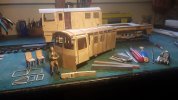Postscript
So, things have come to pass. At the same time as I originally posted this topic I also emailed the maker (late on a Saturday evening). The usual thing.......HELP ! (In a polite constructive manner). Well, first thing on Monday morning I get a phone cal from them, apologising for not getting back to me on the Sunday (now that would be service). Seems as though they came to the same conclusion as to a solution as I had thought about too. "I have produced a set of roof panels for you, still with the etched detail, that are 0.5 mm thick rather than the 1.6 mm supplied. Will that do ?" Too bloody right it will, merci buttercups me old mate. They arrived yesterday, and yes they are a thing of beauty, a testimony to the laser cutter's art and the answer to my prayers.
There was also a suggestion that the supplier had a suspicion that the his stock of (some) 1.6 mm ply might not have been to the spec' ordered or defective in some way. Hence possibly the pliability issues I was experiencing (every pun intended). Looking at them the grain pattern is most certainly not linear, at least on the top layer. My lack of knowledge of the whole steaming thing notwithstanding did not help either.
Morals of this story - be a little more patient, always be nice to those you will be seeking assistance from at all times, never be afraid to ask (because you might not get if you don't) and think outside of the box (was I even asking the right question for starters).
Ho hum, lessons learnt but a wealth of data created here for those having the same issues in the future. I think there is a reason that in the many years of building ply kits the whole steaming pile.........sorry my finger slipped, steaming ply to form it to shape has never reared its head before. The whole process looks a PITA and one to be avoided at all costs. Which is why every other maker has probably engineered their kits otherwise when using this material. Max
P.S. Full disclosure of what is being built here will be posted in good time with the revelation and fulsome praise of the kits maker.








